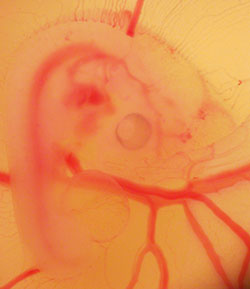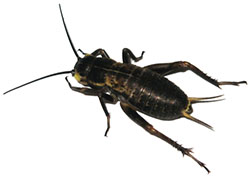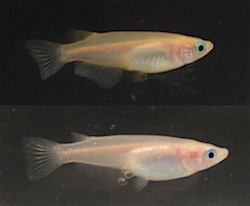- Home »
- Research »
- Model Organisms
Model Organisms
It is fundamental to use model animals for basic biomedical research. There are several model animals that can be used according to research fields of interest. Below, we describe the model animals used in our daily research.
Mus musculus
The laboratory mouse is an essential model animal to study the basic pathophysiology of common and congenital diseases of human through analysis of spontaneous mutant mice, transgenic, and gene-targeting mice.
Gallus gallus
 Since a chick embryo develops in an egg, it is easy to manipulate—you just put fertilized eggs in an incubator and see the embryo from the upper-side cracked egg after a few days. This technique is very popular for performing various surgical manipulations (cut & paste) of the embryonic tissue. For example, you can induce the formation of an additional limb (Dasoku) in the chick embryonic flank by grafting an FGF-soaked bead between the prospective wing and the leg field (see the textbook, Developmental Biology, Gilbert, Sinauer). Furthermore, the in ovo electroporation technique makes it easier to perform ectopic gene expression in the embryo, facilitating functional analysis of any genes using chicken. Also, transgenic chicken would be available in the near future.
Since a chick embryo develops in an egg, it is easy to manipulate—you just put fertilized eggs in an incubator and see the embryo from the upper-side cracked egg after a few days. This technique is very popular for performing various surgical manipulations (cut & paste) of the embryonic tissue. For example, you can induce the formation of an additional limb (Dasoku) in the chick embryonic flank by grafting an FGF-soaked bead between the prospective wing and the leg field (see the textbook, Developmental Biology, Gilbert, Sinauer). Furthermore, the in ovo electroporation technique makes it easier to perform ectopic gene expression in the embryo, facilitating functional analysis of any genes using chicken. Also, transgenic chicken would be available in the near future.
Gryllus bimaculatus
 The cricket is a large-sized hemimetabolous insect and has a mode of development that is different from that taken by Drosophila, thus, making it an ideal model insect in the field of evolutional developmental biology (Evo-Devo). In addition, the nymphal leg can regenerate, thus making it a good model system for regenerative biomedical sciences. Classically, the cricket, a singing insect, has been used for studies on neurophysiology of memory and behavior. Since recent analysis has clarified the genomic sequences and genetic modification techniques such as RNA interference and transgenics have been successfully developed, the cricket has become an emerging model insect for various biomedical researches (see the textbook, Developmental Biology, Wolpert, Oxford Univ. Press). Gryllus bimaculatus originally lives in subtropical areas. It grows up to the adult through the first to eighth nymphal stages and the adults lay eggs throughout the year. The adult cricket attains a length of 3 cm and a weight of 1 g. G. bimaculatus has 14 autosomes and 1 sex chromosome (XO for males and XX for females). The genome size is estimated to be 1.8 Gb.
The cricket is a large-sized hemimetabolous insect and has a mode of development that is different from that taken by Drosophila, thus, making it an ideal model insect in the field of evolutional developmental biology (Evo-Devo). In addition, the nymphal leg can regenerate, thus making it a good model system for regenerative biomedical sciences. Classically, the cricket, a singing insect, has been used for studies on neurophysiology of memory and behavior. Since recent analysis has clarified the genomic sequences and genetic modification techniques such as RNA interference and transgenics have been successfully developed, the cricket has become an emerging model insect for various biomedical researches (see the textbook, Developmental Biology, Wolpert, Oxford Univ. Press). Gryllus bimaculatus originally lives in subtropical areas. It grows up to the adult through the first to eighth nymphal stages and the adults lay eggs throughout the year. The adult cricket attains a length of 3 cm and a weight of 1 g. G. bimaculatus has 14 autosomes and 1 sex chromosome (XO for males and XX for females). The genome size is estimated to be 1.8 Gb.
Oryzias latipes
 The medaka is a small fish used in areas of biological research since
long ago in Japan. It spawns eggs daily in the appropriate lighting and
temperature condition. The melanophores on the body surface were lost
in some strains of medaka, which enables light to penetrate into brain
and other organs. It is advantageous for investigating the
physiological effect of light. Recent development of genome editing
technique extensively promotes the research using gene-targeted medaka
fishes.
The medaka is a small fish used in areas of biological research since
long ago in Japan. It spawns eggs daily in the appropriate lighting and
temperature condition. The melanophores on the body surface were lost
in some strains of medaka, which enables light to penetrate into brain
and other organs. It is advantageous for investigating the
physiological effect of light. Recent development of genome editing
technique extensively promotes the research using gene-targeted medaka
fishes.